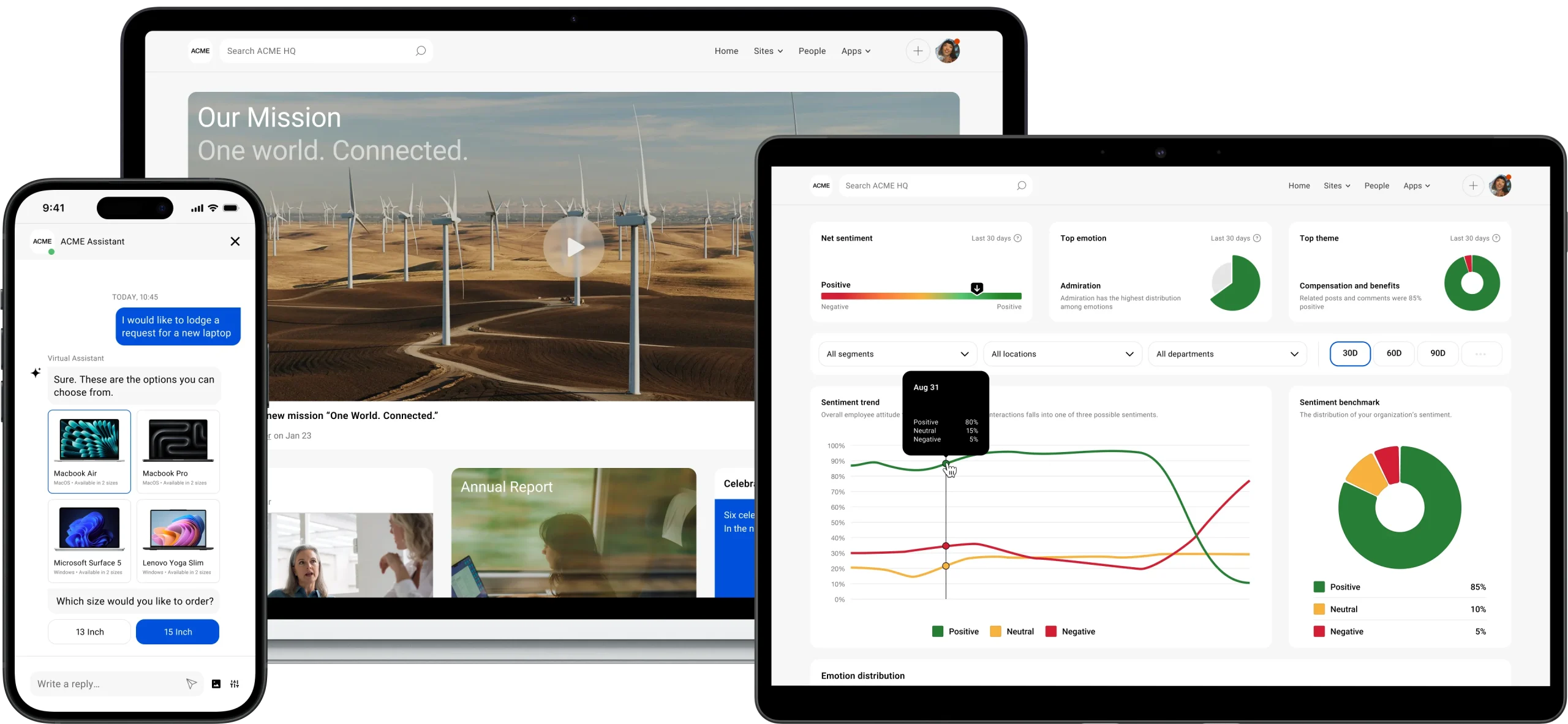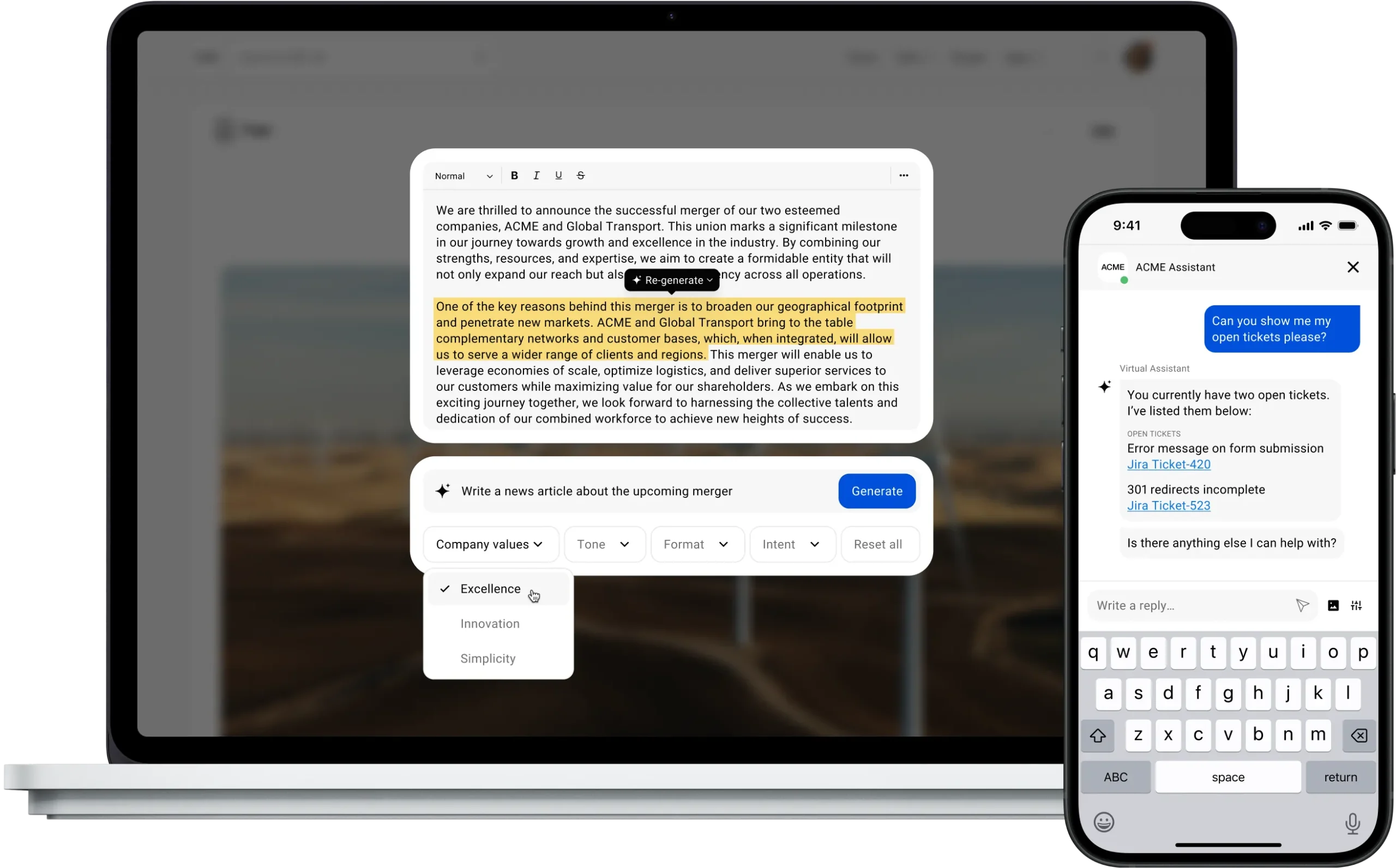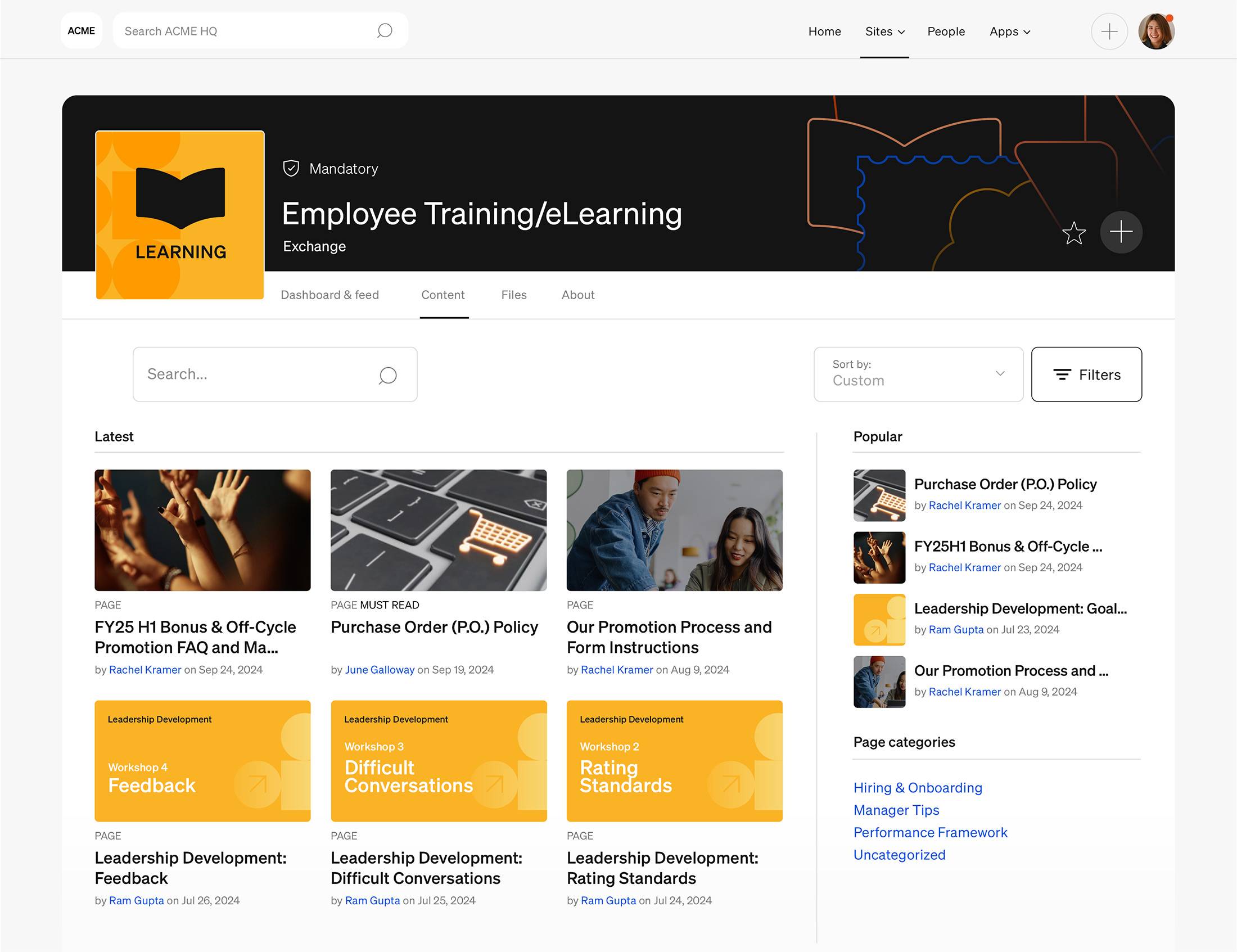Change management definition
Change management is a structured process that helps organizations smoothly plan, manage, and adapt to changes — whether it’s adopting a new technology, navigating leadership shifts, refining processes, or scaling for growth.
The success of these changes depends on the sponsors, change leaders, project managers, people managers, and impacted employees who must adopt and use them. Research shows that organizations with strong change management practices are 7x more likely to meet or exceed their project goals, driving long-term growth and resilience.
Key elements of change management include:
- Assessing the impact of change on processes, systems, and employees
- Preparing and supporting employees throughout the transition
- Developing and executing a plan for change, including communication and training
- Monitoring progress and outcomes to ensure the change achieves its intended goals
- Adjusting strategies as needed to address challenges or resistance

What is organizational change management?
Organizational change management (OCM) is a type of change management framework that addresses the people side of change — helping employees understand, accept, and adopt new ways of working. Both approaches are critical, but OCM takes a broader, organization-wide view, aligning culture, leadership, and employee mindsets with business goals. At the same time, change management focuses more deeply on project-level execution and the steps needed to implement change.
In the end, it’s all about guiding employees through the transition, reducing resistance, and making sure the change is successful and sustainable.
Importance of change management
Constant change is the new normal in today’s workplace. 96% of organizations are undergoing some phase of transformation. Another study shows 73% of organizations anticipate more change initiatives in the near future, with just 13% expecting fewer. This underscores the importance of a structured change management approach — one that prepares employees, aligns leadership, and minimizes disruption — so businesses can adapt quickly, drive growth, and stay resilient in an unpredictable environment.
Organizations prioritizing change management are better positioned to navigate transitions successfully and achieve their intended outcomes. Research shows that 47% of organizations that integrate change management are more likely to meet their objectives than the 30% that do not.
To prepare employees to lead change, leaders need to create a workplace culture that thrives on agility and promotes transparency.
Types of change management
Not all changes are the same. Some are small shifts in structure, while others can completely transform an organization’s operations. Here are some of the most common forms of change:
- Developmental change: Focuses on improving existing processes, skills, or performance within the organization. It’s about fine-tuning what already works — making systems more efficient, enhancing team collaboration, or upskilling employees. Developmental change is usually incremental and low-risk but essential for continuous growth.
- Transitional change: Transitional change happens when an organization moves from an old way of working to a new one. It’s about replacing existing systems, processes, or structures with something different, like changing its CRM or core technology that fits the company’s long-term vision.
- Transformational change: This kind of change usually happens when a company faces major challenges or opportunities. It could be due to digital disruption, changing customer demands, market competition, or new business goals. For example, a company might shift from selling products in stores to fully operating online, or from manual work to using AI and automation.
Change management modules
There are several different change management models that organizations can use to manage change; here are a few of them:
Lewin’s change management model
Named after psychologist Kurt Lewin, this model is one of the simplest and most widely used frameworks for managing organizational change. It involves three steps: unfreeze, change, and refreeze. Here is a breakdown of each of them:
- Unfreeze: This is the preparation phase where you assess how things currently work and identify what needs to change to reach your goals. It’s also the perfect time to practice corporate communication to make employees and stakeholders understand the ‘what’ and ‘why’ behind your decision.
- Change: This is the action phase. The new processes, systems, or ways of working are introduced and put into practice. Consistent communication, hands-on training, and ongoing support are key to helping employees adjust and stay engaged throughout the transition.
- Refreeze: This phase helps you avoid falling back into the old way of doing things. Review how the new processes work and measure change management metrics and key performance indicators (KPIs) to see how well you’ve reached your goals.
Kotter’s 8-step change model
The model was originated by John Kotter, a Harvard Professor, in 1996 and described in his book “Leading Change.” This model includes eight steps that are as follows:
- Create a sense of urgency to inspire action and commitment.
- Assemble a diverse change team with strong leaders and cross-functional change champions.
- Define a clear, strategic vision to align everyone on the goal.
- Communicate early and often to ensure everyone understands the change and their role in it.
- Spot roadblocks quickly and resolve anything slowing progress.
- Set short-term, achievable milestones to build confidence and maintain focus.
- Sustain momentum by celebrating wins and reinforcing progress.
- Embed the change into everyday workflows to ensure long-term success.
Prosci’s ADKAR model
Prosci’s ADKAR model, developed by Prosci founder Jeff Hiatt, involves five main goals that set the base for the change management process.
- Awareness: Help employees understand why the change is needed
- Desire: Build motivation and willingness to support the change
- Knowledge: Provide the right training and information to make the change happen
- Ability: Ensure employees have the skills and tools to implement the change
- Reinforcement: Strengthen and sustain the change through ongoing support and recognition
McKinsey 7-S change management model
The McKinsey 7-S model, outlined in the book “In Search of Excellence” by Peters and Waterman, focuses on coordination rather than structure. It highlights the seven components that have been categorized into two categories: Hard and Soft.
Hard elements
- Strategy: The plan of action a company uses to achieve its goals and stay competitive during change.
- Structure: The way the organization is organized — who reports to whom, roles, and responsibilities.
- Systems: The daily processes, workflows, and tools that support business operations.
Soft elements
- Shared values: The core beliefs and culture that guide employee behavior and business decisions.
- Style: The leadership approach and management style that shape how decisions are made and communicated.
- Staff: The organization’s people — their capabilities, roles, and how they’re developed and retained.
- Skills: The competencies and abilities that exist within the organization to execute tasks and drive change.
Best time to apply change management
Remember, not every organizational change requires a full-scale change management process. It’s most necessary when the change will likely face significant resistance or affect the entire organization.
Examples of situations that commonly call for change management include:
- Adoption of new technology to streamline operations
- Updating processes or policies to increase efficiency
- Introduction of a new product or service offering
- Change in leadership and management.
- Implementation of new work culture programs
- Combination or acquisition of companies
- Unforeseen crises stemming from economic or socio-political issues
How to build a change management plan?
With 60-70% of organizational change initiatives falling short, the risk of failure is real — but avoidable. When approached with the right strategy, change management empowers organizations to adapt with confidence and turn disruption into opportunity. Here are a few essential steps to make change smooth, structured, and successful:
Define the reason for change
Change isn’t easy to adapt. Before introducing any organization-wide change, pause and ask yourself:
- What is your business trying to change?
- Who will be mostly impacted by the change?
- How significant is this change going to be?
- What problems will this change fix?
Explaining ‘why’ with every minute detail isn’t possible; therefore, a broad narrative that explains the proposed change is crucial. Craft a compelling story to create a shared understanding of an organization’s current state and its next steps. During times of uncertainty, the change story will cut through confusion and lead people forward.
Tell a compelling change story that clearly communicates the ‘what’ and ‘why’ behind the transformation, creating understanding and buy-in.
Set clear success metrics
Clearly define what success looks like during the implementation process. Collaborate with your change management team to establish measurable goals. Consider including key performance indicators such as:
- Timelines for key implementation phases
- Adoption rates or training completion percentages
- Utilization of new processes or tools across teams
Choose your change champions
Change management isn’t something you do to employees — it’s something you do with them. According to McKinsey, 70% of change initiatives fall short because leadership treats employees as passive recipients instead of active participants.
Therefore, pick the right people (from management and colleagues) within your organization to lead and support the change effort. They help promote the vision of the change, motivate others to get on board, offer real insights into employee sentiment and identify potential roadblocks early. Hold meetings to work through your change plan with this team and encourage them to communicate updates to employees, help with implementation, and set up training sessions.
Craft and execute your plan
The next step is to focus on turning your strategic vision into actionable steps and making the change happen across your organization. In your plan, include objectives, timelines, roles and responsibilities, communication strategies, training schedules, and support resources. Make sure all necessary details are included so those responsible for execution have everything they need to succeed. Also, decide when to communicate the change to your workforce; don’t leave them in the dark.
Foster transparent and open communication
Gallup research shows that only 41% of U.S. employees strongly agree that they know what their company stands for and what makes it different from competitors, and just 26% believe their organization always delivers on its brand promises to customers. These numbers reveal a communication disconnect between leadership and employees.
Leaders must prioritize honest, transparent, and consistent communication to ensure a smooth transition. Hold town-hall meetings, quarterly department updates, and regular team check-ins to keep everyone informed and engaged. Use personalized and targeted messages to make every change initiative relevant and meaningful to each individual and team.
Related: Master AI for internal communication
Measure, analyze and celebrate
After successful rollout, take time to assess whether the change has delivered the expected results — whether that’s improved workflows, higher adoption rates, or better collaboration. Use employee feedback, performance data, and key metrics to uncover what’s working and where adjustments are still needed. Once gaps are identified, refine your approach to strengthen long-term success. And don’t forget to celebrate the team’s early victories, both big and small — recognizing progress keeps your team motivated and builds a culture that embraces change.
Strategies of an effective change management process
HR professionals know that navigating company transitions smoothly involves a lot of effort and time. Yet change initiatives fail. Research from Gartner shows that employees’ support of change initiatives fell from 74% in 2016 to just 43% in 2022. This could be due to leaders’ lamenting resistance to new ideas, lack of effective internal communication, or misguided implementation methods that overlook the human side of change.
However, with the right strategy and technology, organizations can improve the success rate of their change initiatives. Here are a few of them:
Use advanced analytics to guide smarter decisions
Data ensures change initiatives are on track and delivering real impact. Using comprehensive data and predictive insights helps leaders gain a real-time understanding of how change initiatives are progressing, where resistance may arise, and which strategies are most effective.
With advanced analytics, you can:
- Monitor employee engagement and sentiment in real-time to spot resistance or roadblocks early.
- Measure what’s working (and what’s not) so you can quickly adjust and improve your change strategy.
- Use predictive insights to stay ahead of potential challenges before they turn into bigger issues.
- Bring together data from across systems for a clear, unified view of your change efforts — so everyone stays aligned.
And the right tools can make this even easier. Introducing Simpplr, an AI-powered modern intranet platform with built-in advanced analytics, gives organizations valuable real-time insights into employee behaviors and sentiment, so you can adapt strategies as needed.

Encourage input and feedback across all levels
Let voices ring. Successful change doesn’t happen in isolation — it’s a shared effort. Encourage honest feedback and use the insights to appeal to employees. For instance, if your analytics or conversations reveal that employees are struggling to adopt a new system, use that feedback to adjust training, simplify processes, or offer more hands-on support.
People more readily buy into the change they help plan and structure. Inviting feedback during focus groups, open forums, and hackathons eases the friction of change initiatives.
Use AI to personalize and target communications
When it comes to change, a one-size-fits-all message rarely works. AI can personalize employee communications to resonate more with individuals on a personal level. Simpplr’s smart personalization analyzes user behavior, preferences and historical data to deliver tailor-made content recommendations and serve up relevant information automatically — ensuring that employees receive the information that matters most to them.

Related: How to use AI to personalize and target internal communications
Practice clear and regular communication
According to Gartner, 72% of leaders don’t know what employees need to do differently during change due to their disconnection from day-to-day work and shifting priorities. Clear, transparent, and regular communication is essential at every phase of business development. Leaders need to go beyond one-time announcements and focus on keeping the conversation alive — explaining the “what,” “why,” and “how” of the change at every stage. When people understand the vision, the plan, and their role in it, they’re more likely to stay engaged and committed.
Offer training and support
No matter how well-designed a change is, people need the right tools and knowledge to make it last. An essential element of effective management is the ability to provide professional development opportunities, as this is one of the most important determinants of an employee’s loyalty to the company. A Pew Research Center survey reveals that lack of career advancement opportunities was among the three most common reasons people quit jobs.
When you invest in training and continuous learning, you don’t just ease the transition — you show employees that their growth matters. This not only improves adoption of new systems and processes but also boosts engagement, loyalty, and long-term retention.

Focus on an effective and productive workforce
Too many organizations think of employee productivity as productivity time. They focus on productivity time — getting employees to work more — instead of employee productivity — getting employees to produce more.
An effective workforce is one that’s engaged, supported, and equipped with the tools and clarity they need to deliver meaningful results. When employees understand the “why” behind change and have the right systems in place, they naturally become more productive — not because they’re working harder, but because they’re working smarter.
Empower and train your managers
7 in 10 organizations depend on top-down leadership to guide employees through change. While executive leaders set the vision, this traditional approach can limit innovation, slow adoption, and leave employees feeling disconnected from the process. Therefore, empower your people managers and employees to take the lead on change initiatives.
You know the importance of engaging your employees, but it can be tough to find time for this important work for busy executives. Take the leadership engagement challenge to know if your people are ready for the next transformation.

Example of change management
Microsoft’s change strategy to adopt new sales automation tools
In 2020, the Microsoft Business Operations and Programs team in Microsoft Digital partnered with teams across the company to replace fragmented, inconsistent reporting systems with MSX Insights (MSXi), a modern business intelligence platform. The objective was to create a single, reliable source of truth that could boost efficiency, enhance data-driven decision-making, and support Microsoft’s evolving sales strategy.
To facilitate this transition, they employed the Prosci ADKAR model, focusing on Awareness, Desire, Knowledge, Ability, and Reinforcement, ensuring stakeholders were informed, trained, and supported throughout the change. Pilot programs across different regions, coupled with telemetry data, allowed for real-time feedback and adjustments, addressing concerns like data accuracy and user trust. This comprehensive approach led to widespread adoption, with over 30,000 users in 95 countries, and significantly increased engagement from leadership.
Putting it all together – How Simpplr can help
Change is good, but managed change is better. Poor communication, clunky interfaces, impersonal experiences and complex system implementations are common reasons why change initiatives fail. With Simpplr, an AI-powered intranet platform, you address these challenges by understanding employee needs, personalizing their experiences, and communicating the “why” behind the change clearly. Beyond that, you serve your customers better, and the business can run more efficiently when workers have a single platform to communicate, collaborate, and access knowledge.
Get a live demo to leverage the true potential of organizational change across industries with Simpplr today!

Watch a 5-minute demo
See how the Simpplr employee experience platform connects, engages and empowers your workforce.
- #1 Leader in the Gartner Magic Quadrant™
- 90%+ Employee adoption rate







